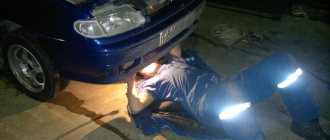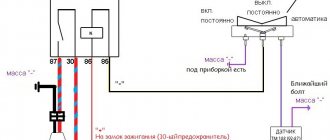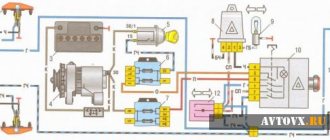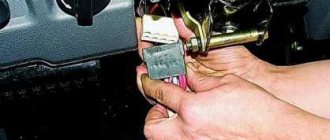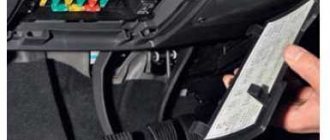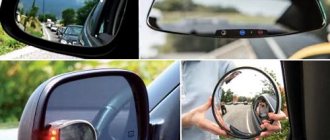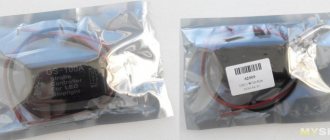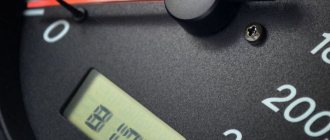External car lights
At the beginning of this article, a few words about what external lighting devices a car may have. This information is primarily intended for those who are studying at a driving school and do not yet understand what these or other headlights or lanterns are intended for.
Note. The topic “lighting devices” is one of the most difficult in a driving school, because... It is difficult for a driver candidate who has never driven before to remember the similar names of light devices and the rules for their use.
parking lights
Dimensions are small light devices located approximately at the corners of the car (4 pieces in total). They do not shine very brightly and are primarily designed so that drivers of other cars can understand in the dark where your car begins and ends.
Daytime Running Lights
DRLs are light devices in the front of the car (2 pieces), which shine quite brightly. They are designed to improve visibility of the car from the front during daylight hours.
Daytime running lights should not be used at night because... at night, they can blind oncoming drivers due to their high brightness. However, they do not illuminate the road.
Low and high beam headlights
Low beam (2 bulbs) and high beam (2 bulbs) headlights are the main lighting devices that are designed to illuminate the road in front of the car.
Fog lights
PTF – 2 headlights in the front bumper of a car, designed to illuminate the road in poor visibility conditions.
Fog light
Fog light - a red light at the rear of the car, designed to improve the visibility of the car in poor visibility conditions. This light device is very bright and in good weather it can blind drivers of cars behind.
How to connect additional headlights?
Additional headlights are those optical elements that are installed to improve the car for driving at night.
Since standard lighting equipment often provides very average illumination levels, additional light can create maximum visibility on the highway, as well as off-road. That is why such headlights are often installed on the car by SUV owners, as well as those who often drive at night and in poor visibility conditions. Most often, such optics are made of LED or xenon. The first option seems to be the most preferable, since xenon has too strong brightness parameters and more often blinds oncoming drivers, which is fraught with the occurrence of an accident. How is additional light connected?
To connect, you will need the headlights themselves, a relay, several fuses, and wiring. Most often, all these elements come complete with lighting equipment. The headlights are connected via a fuse with a low ampere rating, and according to this circuit, the control is connected to the ignition switch. The wire with positive marking is connected to the lock, after which it goes to the backlight button on pin 86 of the relay. The main wire can be taken from the wiring of the low, high or fog lights. The first scheme is more convenient, since when the key is removed, the light of the additional optics turns off.
Switching on can also be done using a special toggle switch. This decision is more justified for a number of reasons:
- Additional headlights
may be too bright, especially if they are xenon, and if you turn regular high beams on and off in normal mode, you will have to do the same with additional optics, which reduces its service life. - High brightness of headlights, when combined with high beams, can blind oncoming drivers, which creates the risk of an accident, and can also blind the owner of the car itself if the trip takes place in winter.
- High loads on the battery, and if calculated incorrectly, it will last much less.
The optimal connection diagram implies that the standard switching device regulates the high beam, and additional optics are switched on as needed. Thus, you can turn on additional headlights either separately or together with the main beam, and the duration of manipulation with the light will be minimal.
Automotive optics from Wesem-Light.ru, large selection and best prices. Our specialists will help you choose car headlights for your car.
Driving during daylight hours
In good visibility
When driving during daylight hours, the vehicle must have one of the following lights on:
- low beam;
- Daytime Running Lights;
- fog lights;
If the car has all the listed devices, then it makes sense to use DRL. These lights are brighter and use less electricity.
When driving, the following can also be turned on:
- parking lights.
It is prohibited to use:
- fog lamp.
In case of insufficient visibility
One of the following lighting fixtures must be used:
- low beam headlights;
- high beam headlights.
In this case, the main beam cannot be used:
- in populated areas on illuminated roads;
- when oncoming vehicles pass;
- when blinding drivers of passing or oncoming cars.
Additionally, the car may include:
- fog lights;
- fog lamp;
- parking lights;
- Daytime Running Lights.
What will tourists enjoy about the weather in Crimea in January?
Note. The rear fog light is specifically designed for use in conditions of poor visibility, but in practice no more than 10 percent of drivers use it. The rest, apparently, do not know the relevant rules.
Legal installation of additional light according to the illuminance index
According to the ECE standard, headlights installed in a car must not exceed a maximum illuminance index value of 100 , which is calculated from the sum of the car's standard headlights and the additional OSRAM headlights that are connected. Each certified light fixture has this index on its body and all you need to do is calculate the sum of all light index values from each light fixture and make sure that this sum does not exceed 100. There are also restrictions on the number of additional headlights that can be connected. For example, for 12V passenger cars, you can connect only two additional high beam headlights to the main two high beam headlights, and for 24V commercial vehicles, you can connect no more than four additional additional high beam headlights to the two main headlights.
Below we give an example of how the illumination value in your car is calculated if you connect an additional OSRAM light with an index value of 10 to your car.
First of all, you need to look at the housing markings of your standard headlights, for example, on them we see the following designations:
This means that the illuminance index of your headlight is 12.5. Thus, you need to multiply 12.5 by 2 since you have 2 standard headlights, so we get a total of 25. Next, we add the OSRAM illumination index to this value. If you install an OSRAM auxiliary headlight with index 10, then we get a total value of 20 since we install 2 additional OSRAM headlights. In total, the overall illumination index in your car will be 45. It is calculated using the following formula:
It is less than 100, which means that the installation of headlights in accordance with ECE lighting requirements was legal.
Like each standard car headlight, OSRAM additional headlights have their own illumination index. You can get acquainted with the headlight illumination index by looking at their housing, and you can familiarize yourself with the OSRAM headlight illumination index from the catalog with a description of the technical characteristics.
Driving in the dark
One of the following lighting fixtures must be used:
- low beam headlights;
- high beam headlights.
In this case, the main beam cannot be used:
- in populated areas on illuminated roads;
- when oncoming vehicles pass;
- when blinding drivers of passing or oncoming cars.
Additionally you can use:
- fog lights;
- fog lamp (only in case of poor visibility);
- parking lights.
The installation of additional headlights must meet the following requirements:
- Illumination index - the total illumination of all devices in the car should not exceed 100 .
- Total number of headlights - depending on the type of car 12V or 24V, there is a maximum number of headlights that can be installed on a car at the same time. In this case, additional headlights must be installed in pairs.
- Connection requirements - depending on the type of product (high beam, side light or rear light), they must be connected strictly to the car's standard headlights so that they work synchronously with each other. For example , if you install additional high beam headlights, you need to connect them to the main high beam so that when you turn on or off the main beam of the standard headlights, the additional high beam also switches.
- Location Requirements – There are specific location requirements for the side and rear lights in the vehicle.
Rules for using lighting devices
The rules for using headlights and flashlights in various situations are discussed in detail above, but remembering them is not so easy. Therefore, we will consider them in a more compact form.
Prohibited:
- use the rear fog lamp when visibility is good;
- use high beams in populated areas on illuminated roads, when passing oncoming traffic, when blinding passing or oncoming drivers;
- do not use low or high beams at night, with insufficient visibility, in a tunnel;
- do not use DRLs, low beams or PTF during the day;
- Do not use clearance when parking in poor visibility conditions or on an unlit section of the road at night.
All other options and combinations of lighting devices are not a violation.
In conclusion, let me remind you that fines for improper use of lighting devices are discussed in a separate article:
Fines for improper use of headlights
Good luck on the roads!
We also recommend reading: Fine for xenon in 2020 Fine for driving without low beams in 2020 Headlight tinting and fines for its use
Penalty for blue bulbs in headlights in 2020 Limited and insufficient visibility in traffic regulations New fines for installing diode and xenon bulbs
Author: - 01/10/2016
A modern car has as many as 8 different lighting devices installed (there is also a backlight for the rear license plate, but in this case we are not interested in it). And we need to use these 7 lighting devices: headlights, flashlights, foglights and other things in different ways, depending on as many as 8 conditions. Let's list lighting devices and conditions for their use for 2020!
So, the car has so-called external lighting devices. These include:
- headlights: low beam;
- headlights: high beam;
- rear lights;
- fog lights (PTF);
- rear fog lights;
- parking lights;
- daytime running lights (DRLs).
And among the conditions for including certain lighting devices in the traffic rules, there are the following:
- daylight hours;
- dark time of day: illuminated road;
- dark time of day: unlit road;
- low visibility conditions;
- standing/moving car;
- trailer/towed vehicle;
- populated/non-populated area.
Are you scared? It's actually not all that scary. Let's find out when and in what cases you need to turn on the headlights, fog lights, high or low beam headlights and dimensions. Data current as of October 18, 2020. For convenience, we will consider the rules for using car lights depending on the time of day and other conditions, and answer some pressing questions. And at the end of the article we will provide a table as a simple way to remember when which lights need to be turned on on the car.
Telegram online web in Russian: login telegram web
What light should I use during the day?
During the day, namely, during daylight hours, we can use daytime running lights (19.5 traffic rules). But instead of DRLs (not only if they are not installed in the car, but also at the driver’s request), you can use low beam headlights or fog lights (19.4 + 19.5 traffic rules).
During daylight hours (provided that there are no conditions of insufficient visibility), you need to turn on:
- Daytime Running Lights;
- dipped headlights;
- fog lights (but not in combination with low beams or DRLs).
During daylight hours you should not turn on:
- high beam headlights;
- rear fog lights.
What light to use at night?
The dark time of the day in the traffic rules is defined as “the period of time from the end of the evening twilight to the beginning of the morning twilight” (1.2 of the traffic rules). Thus, the dark time of the day includes the entire night, evening from the end of twilight and morning until the beginning of dawn.
At night you need to turn on:
- dipped or high beam headlights while driving (see below under what conditions high beams cannot be used);
- side lights when stopping or parking on the road, as well as on trailers and towed vehicles;
- fog lights - only on unlit sections of roads and only in combination with low or high beam headlights.
Also, in the dark, you can turn on a special spotlight if you have one, provided you are driving outside a populated area and in the absence of oncoming cars.
In the dark it is forbidden to use:
- high beam headlights: in populated areas, if the road is illuminated,
- if oncoming traffic is closer than 150 meters to you or even further and at the same time flashes its headlights at you,
- in any other cases when it is possible to blind drivers (namely drivers, not pedestrians) of oncoming and passing cars;
What light to use in conditions of poor visibility (in fog)?
The conditions of insufficient visibility are also defined in the Rules, so there is no ambiguity here. These conditions include driver visibility of less than 300 meters in fog, twilight, rain, snow, and the like. In general, if the visibility of the road is approximately less than 300 meters, the only time it is night, then these are conditions of insufficient visibility.
In conditions of insufficient visibility, you need to turn on:
- dipped or high beam headlights when moving (see above in the description of lighting at night, in what conditions you cannot use high beams);
- side lights when stopping and parking - low beam headlights, fog lights or rear fog lights together with side lights can also be turned on in conditions of poor visibility (as opposed to the dark).
- fog lights - only in combination with low or high beam headlights (and on roads of any illumination, as opposed to the dark).
- rear fog lights (this is the only condition in which they can be used).
In conditions of insufficient visibility, you cannot use:
- fog lights without low or high beam headlights;
- daytime running lights.
What light should I use in the tunnel?
Traffic regulations regulate the mandatory inclusion of headlights in tunnels (clause 19.1). The rule here is simple: the conditions for using certain lighting devices are the same as in the dark.
When can you use the emergency lights?
Hazard alarms are also considered a lighting device, and traffic regulations clearly regulate the possibility of their use. So, the emergency lights need to be turned on:
- if you get into an accident along with a warning triangle (2.5 traffic rules + 7.1 traffic rules);
- if a situation arises where your car poses a danger;
- when forced to stop in a place where stopping is prohibited (together with an emergency stop sign);
- when towing on a towed vehicle;
- if you are blinded by oncoming traffic.
Terminator 6: Dark Fate
When can you blink your headlights?
Yes, most often drivers blink their headlights (one or more short-term switches of headlights from low beam or DRL to high beam) when warning oncoming vehicles about traffic police officers. However, traffic rules recommend doing this in completely different cases. Which ones:
- to warn other road users about overtaking;
- if you are blinded by an oncoming vehicle.
At the same time, nowhere in the Rules is there a direct prohibition on blinking headlights. However, traffic police officers may regard this as a violation of traffic rules, as a result of which you can easily earn a fine of 500 rubles. Think for yourself, when you blink you turn on the high beams, but in most cases it is prohibited to turn them on.
As you can see, everything is very simple! But let's simplify these Rules for the use of lighting devices even further and present everything in a visual tabular form.
| Conditions/light | Daylight time | Dark time of day, illuminated sections of roads in populated areas | Dark time of day, unlit sections of roads | Tunnel | Insufficient visibility |
| Low beam | + | + | + | + | + |
| High beam | – | – | + | + | + |
| Fog lights | +1 | – | +2 | – | +2 |
| Daytime Running Lights | + | – | – | – | – |
| Rear fog lights | – | – | – | – | + |
Table footnotes:
- Instead of low beam headlights
- Only in combination with low or high beam headlights
And, finally, an official excerpt from the current 2020 traffic regulations, Chapter 19 on external lighting devices.
19. Use of external lighting devices and sound signals. 19.1. In the dark and in conditions of insufficient visibility, regardless of the road lighting, as well as in tunnels, the following lighting devices must be turned on on a moving vehicle:
- on all motor vehicles - high or low beam headlights, on bicycles - headlights or lanterns, on horse-drawn carts - lanterns (if equipped);
- on trailers and towed motor vehicles - side lights.
19.2. High beam should be switched to low beam:
- in populated areas, if the road is illuminated;
- when passing oncoming traffic at a distance of at least 150 m from the vehicle, and also at a greater distance, if the driver of the oncoming vehicle periodically switching the headlights indicates the need for this;
- in any other cases to eliminate the possibility of blinding drivers of both oncoming and passing vehicles.
If blinded, the driver must turn on the hazard warning lights and, without changing lanes, reduce speed and stop.
19.3. When stopping and parking in the dark on unlit sections of roads, as well as in conditions of insufficient visibility, the side lights on the vehicle must be turned on. In conditions of poor visibility, low-beam headlights, fog lights and rear fog lights can be turned on in addition to the side lights.
19.4. Fog lights can be used:
- in conditions of poor visibility with low or high beam headlights;
- at night on unlit sections of roads in conjunction with low or high beam headlights;
- instead of low beam headlights in accordance with paragraph 19.5 of the Rules.
19.5. During daylight hours, all moving vehicles must have low-beam headlights or daytime running lights on to indicate them.
19.6. The spotlight and searchlight may only be used outside populated areas in the absence of oncoming vehicles. In populated areas, only drivers of vehicles equipped in the prescribed manner with blue flashing lights and special sound signals can use such headlights when performing an urgent official task.
19.7. Rear fog lights can only be used in conditions of poor visibility. Do not connect rear fog lights to brake lights.
After all, friends also love interesting articles!
Facebook messenger, what is it. How to use it for communication
Installing halogen lenses
In cases where standard head optics do not provide high-quality road illumination, it is recommended to install additional halogen light sources. To do this, you will need headlights, a block and fuses, wires, a power button, a power relay, heat-shrink tubing, electrical tape, clamp blocks, as well as a set of screwdrivers and wrenches.
First you need to decide on the choice of additional headlights. The best option may be standard devices for which there are mounts in the bumper of your model. If this is not provided by the manufacturer, you can buy any halogen headlights if you have the appropriate certificates. It is better to buy optics complete with wiring and fuses. For standard low beam lamps with a power of 55 W, 10 A fuses and 25-30 A relays are sufficient.
Remember, the optimal connection diagram for halogen headlights is through the low beam relay contact or to the ignition switch. In this case, when the ignition is turned off, the additional headlights will turn off automatically.
This way, you can avoid draining the battery if, for some reason , you suddenly forgot to turn off the headlights forcibly. Additional headlights must be connected via a relay with fuses.
All work on installing additional optics should be done by first disconnecting one of the battery terminals. All wires and connectors must be carefully insulated, and relays and contact buttons must be placed in heat-shrinkable tubes.
Halogen headlights are installed in standard spots on the bumper, if any. If such places are not provided, then the optics should be mounted in accordance with the requirements of the Technical Regulations. After installing the headlights, we install the wiring. One of the headlight wires should be connected to ground in any convenient place by screwing it to the body. The remaining two wires are placed in a corrugated plastic tube and attached to the car's standard wiring with plastic clamps. Then the wires are brought into the interior. Try to arrange the wiring in the area where the relay and fuse panels are located.
Continuation of the story
Is tinting headlights and taillights allowed?
Terms of deprivation of rights - what are they and for what violations?
What is the parking fine?
Why are they deprived of their rights and for how long?
Is it possible to overtake along a continuous line?
What is the penalty for crossing a solid line?
–> — 01/12/2016: Re: When and at what time to turn on the low and high beams,……
On April 1, 2020, strange information appeared about changes in traffic rules, which confused many drivers. The essence of which was changes in the use of low beam headlights. Our team analyzed the sources and we did not find any current amendments to the traffic rules on this topic. This suggests that most likely there was an April Fool's prank, which included large Internet resources.
For violating the rules of driving a car in the daytime without lighting, a fine of five hundred rubles. It is very important to understand that the mandatory inclusion of low beams, regardless of the time of day, was related to the visibility of the car on the road. By turning on low beam headlights, you reduce the risk of an accident because you become more visible to other drivers.
Low beam headlights or daytime running lights in 2020
Based on the current traffic rules (traffic rules), clause 19.5 tells us that “during daylight hours, low beam headlights or daytime running lights must be turned on on all moving vehicles for the purpose of identifying them.” In 2020, the rules did not change and remain the same; daytime running lights or low beam headlights during daylight hours have not been canceled.
Let's try to look for information in the current traffic rules of 2020, but this point remains unchanged. If we look at the acts and regulations, there is also nothing there that relates to lighting devices. If the resolution came into force, there would first be a discussion, but there were no discussions on this matter.
It turns out that the information about canceling the inclusion of headlights in the daytime is a myth. And there is an assumption that the confusion in this issue was caused by amendments to the Ukrainian traffic rules. But they do not relate to the territory of Russia in any way and it will not be possible to refer to them. So be sure to check any changes in traffic rules on official websites and try to trust Internet resources less.
You don't have to turn on your headlights during the day - it's a myth
Low beam headlights or daytime running lights (aka DRLs) still need to be turned on during daylight hours. No new laws regarding external lighting devices have been introduced and are not planned to be introduced. Be careful!
Improving the quality of headlights by legal means
Sometimes owners of inexpensive cars do not have enough lighting provided by their car. Most often this manifests itself in the fall, because then it begins to get dark early, fog falls more often and it rains. Of course, some cars come off the assembly line with full xenon installed. But it will not solve all problems. Several completely legal methods can help, which we will now discuss.
First thing. When considering installing new lighting elements, you should take a few simple steps. Try looking inside your car's headlights. Is there anything extra in there that is preventing the lamp from properly interacting with the reflector? If this is the case, then simply disassemble the headlight, remove the bulb from the socket and wash the reflective elements. If necessary, replace the light bulb, there is a possibility that this is the problem. Over time, they weaken and do not shine brightly enough.
If the headlights do not need to be washed, or the procedure did not give any desired result, then try the next method. Install an additional relay. The essence of this method is to connect the low and high beams to the battery using an additional relay. This will make it possible to increase the voltage in the lamp to 14 volts, thereby increasing the light performance of the headlight by approximately 20%.
It is also possible to install more powerful light bulbs in the headlights, because the more powerful the light source, the brighter the lighting will be. But you can’t put any kind of light bulbs in the headlights. It is necessary to take into account the maximum possible options for your car, since installing a lamp that is too powerful can lead to burnout of the reflector and even deformation of the headlight from overheating. As a safer alternative, you can use light bulbs with low wattage and high luminous efficiency. Their price is much higher, but this option is much safer - overheating of the headlight and destruction of the reflector will definitely not happen.
Installing bi-xenon lamps is considered not entirely legal, but despite this, most drivers use this option. It is quite easy to use such lamps on your car. The lamps themselves and ignition units are supplied in the kit, and installation will not take much time even for a not very experienced mechanic. You should be aware that this type of lighting is not suitable for working in headlights with classic lamps, therefore there is a possibility that the light will be incorrectly focused and distributed. Attempting to adjust such headlights will be useless. For better performance of bi-xenon lamps, it is recommended to spend a little more money and purchase additional lenses (preferably not cheap ones, but more expensive ones). With them the result will be much better. Installing such lenses will not take much time and labor.
As practice shows, manipulations that improve the quality of car light are in wide demand among car enthusiasts. And the options provided here do not entail fines and increase comfort and safety during a trip in poor visibility.
- Business savior. Special report from FIAT Doblo production in Turkey
See all photo news >>
